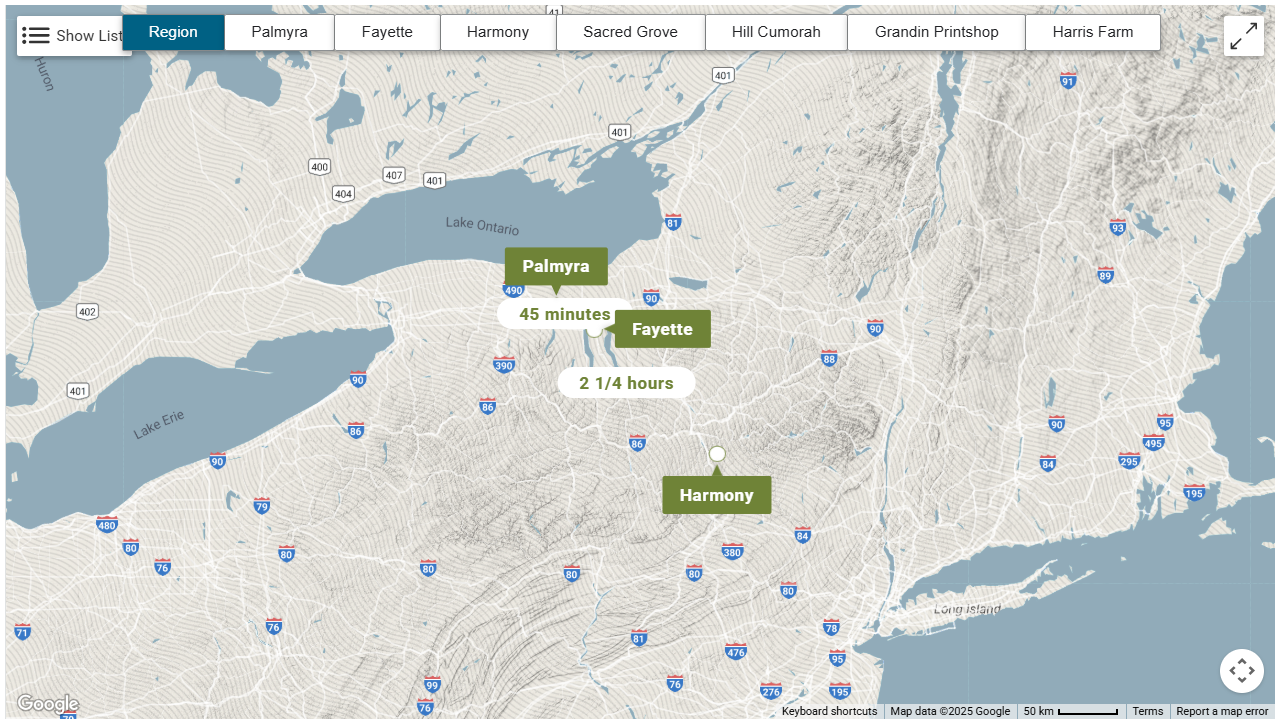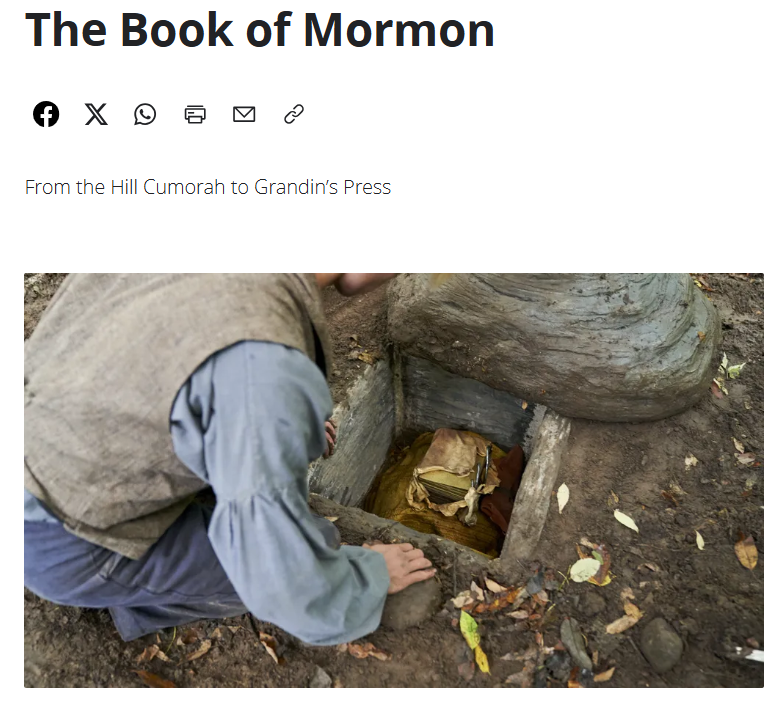In the ongoing pursuit of clarity, charity and understanding, and always in the hope of improvement, we propose some additions to the narrative on a Church website regarding Cumorah.
One reason why Latter-day Saints don't know the history of Cumorah is because of explanations such as the following on the Church History Department's section on learning about historic sites and museums.
https://www.churchofjesuschrist.org/learn/locations/hill-cumorah?lang=eng
The site does contain some useful information, but it completely ignores the historical sources and teachings of the prophets about Cumorah. It doesn't even provide links to those sources. Worse, it includes confusing and inconsistent material.
Original in blue, comments in red, and proposed emendations in green. (An "emendation" is an alteration intended to improve.)
_____
Hill Cumorah in Manchester, New York, is the place where Joseph Smith met annually with the angel Moroni from 1823 to 1827 and obtained the gold plates from which the Book of Mormon would be translated.
This is accurate but incomplete. It leaves readers without an answer to the obvious question: "Why is this hill named Cumorah?"
It's not a difficult question to answer.
Proposed emendation. Add the following sentence:
The hill is called "Cumorah" because that's how Moroni identified it when he first visited Joseph in September 1823.
Top of Cumorah
Proposed additional photo: Show the view from the top of the hill facing west, as Oliver Cowdery described it.
The events that took place at the Hill Cumorah were foundational to the establishment of The Church of Jesus Christ of Latter-day Saints. Directed by the angel Moroni, Joseph Smith found the golden plates deposited in the hill on September 22, 1823. note 1
Note 1. See https://www.josephsmithpapers.org/paper-summary/lucy-mack-smith-history-1844-1845/41 and D&C 128:20.
Joseph then met the angel there on the same date for the next three years until he was finally allowed to obtain the plates on September 22, 1827. From those plates, Joseph Smith translated the Book of Mormon by the gift and power of God.
This incomplete explanation omits an essential part of the narrative Joseph and Oliver gave us.
Proposed emendation. Delete the last sentence and replace it with what Joseph actually said:
"I obtained them and the Urim and Thummim with them, by the means of which I translated the plates and thus came the Book of Mormon." Note 2
Note 2: See https://www.josephsmithpapers.org/paper-summary/elders-journal-july-1838/11
The site includes a variety of trails, the Angel Moroni Monument, and a visitors’ center.
No emendations needed.
Although it is commonly known as the Hill Cumorah, this name was not used sometime after the pivotal events of 1823–1827.
This confusing sentence appears to be missing a word. We infer the historians meant to write "this name was not used until sometime after the pivotal events of 1823–1827." But if so, then the sentence is misleading.
There are no known documents from 1823-1827 regarding the plates, the hill, Moroni, the First Vision, or any other Restoration events. Everything we know about this time period was recorded retrospectively. We assume people talked about these events at the time they occurred. They just didn't write anything down until later.
In fact, the claim that Joseph met Moroni in September 1827 is based on retrospective accounts.
To be consistent, historians would observe that "the name "Moroni" was not used until sometime after the pivotal events of 1823-1827." Instead, relying on retrospective accounts, they state the dates of Moroni's visit as a fact. Which is fine.
But to be consistent, they should also state as a fact that it was Moroni who identified the hill as Cumorah in the first place.
Proposed emendation. Replace this confusing sentence with the following.
The hill is commonly known as the Hill Cumorah because that is what Moroni called it when he first visited Joseph Smith. Oliver Cowdery explained that it was a fact that this is the same hill referenced in Mormon 6:6. Note 3.
Note 3. See http://www.josephsmithpapers.org/paper-summary/history-1834-1836/90
In the latter half of the nineteenth century, many residents of Wayne and Ontario Counties referred to it as “Gold Bible Hill” and “Mormon Hill.”
Proposed emendation. Add the following sentence.
The Church acquired the Hill Cumorah in 1928 and restored the name Cumorah, by which it is still known today.
However, many early members of the Church, including some of Joseph Smith’s closest friends and family members, referred to the hill as “Cumorah” at various times in Joseph Smith’s lifetime.
While technically accurate, this is misleading because it implies these "early members of the Church" invented the term or adopted a false narrative. Historians should explain that Lucy Mack Smith related what Moroni told Joseph the first night, that Joseph referred to the hill as Cumorah even before he got the plates, that Oliver Cowdery explained it was Moroni who called the hill Cumorah, that Oliver declared it is a fact that the New York Cumorah is the same as the Cumorah/Ramah mentioned in the text, that David Whitmer met the messenger who had the plates and was going to Cumorah before going to Fayette, etc.
Proposed emendation. Replace the sentence with the following.
Many early members of the Church, including some of Joseph Smith's closest friends and family members, related accounts that affirmed Moroni's identification of the hill as Cumorah.
This is likely because Moroni, the Book of Mormon’s final author and the angel who met with Joseph Smith, wrote that he would “hide up the record in the earth” once he had finished adding a few words of his own (see Mormon 8:4, 14).
This speculative sentence should be omitted because there are zero historical documents that state, imply, or even suggest that this is the reason why Joseph and his contemporaries referred to the hill as Cumorah. Instead, the historical references indicate that it was Moroni himself who identified the hill as Cumorah, along with the messenger to whom Joseph gave the plates before leaving Harmony (whom Joseph identified as one of the Three Nephites).
Proposed emendation. Delete the sentence.
Since this passage follows Moroni’s account of the great final battle between the Nephites and Lamanites, which occurred at a hill called Cumorah, many assumed that Moroni buried the plates in the same hill (see Mormon 8:2–4) and it was there that Joseph later received the record.
This speculative sentence should be omitted because there are zero historical documents that state, imply, or even suggest that this is the reason why Joseph and his contemporaries referred to the hill as Cumorah. To the contrary, President Cowdery stated it was a fact, not an assumption.
Proposed emendation. Delete the sentence.
One of Joseph Smith’s later letters likewise refers to the “glad tiding from Cumorah” and the visit of “Moroni, an angel from heaven” (Doctrine and Covenants 128:20).
By changing the word order and omitting part of the reference, the historians have changed the meaning of Joseph's letter. The entire sentence demonstrates that Joseph learned the name Cumorah from Moroni before he received the plates. Moroni told him about "the book to be revealed." (emphasis added)
Proposed emendation. Replace the edited quotation with the full quotation.
Glad tidings from Cumorah! Moroni, an angel from heaven, declaring the fulfilment of the prophets—the book to be revealed. (Doctrine and Covenants 128:20)
While the Church “does not take a position on the specific geographic locations of Book of Mormon events in the ancient Americas,” records kept by Joseph Smith and his contemporaries make it clear that this hill is the place where Joseph Smith met with Moroni and where Joseph received the plates containing the Book of Mormon (see Gospel Topics: Book of Mormon Geography).
The entry on Book of Mormon Geography does not mention Cumorah. As such, it retains the teachings of the prophets from the beginning because they always emphasized two things: (i) Cumorah is in New York and (ii) we don't know the location of the other events in the New World.
Proposed emendation. Replace the sentence with this.
While the Church “does not take a position on the specific geographic locations of Book of Mormon events in the ancient Americas,” the prophets have consistently taught two things: (i) Cumorah is in New York and (ii) we don't know the location of the other events in the New World. Additionally, retrospective records kept by Joseph Smith and his contemporaries make it clear that this hill is the place where Joseph Smith met with Moroni and where Joseph received the plates containing the Book of Mormon (see Gospel Topics: Book of Mormon Geography).




















